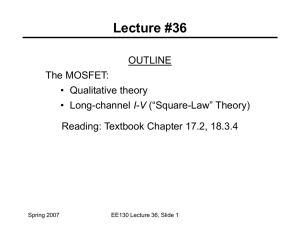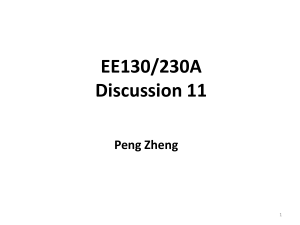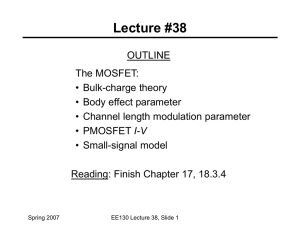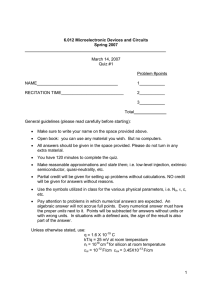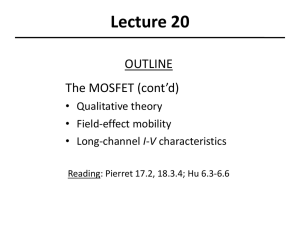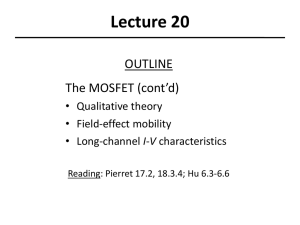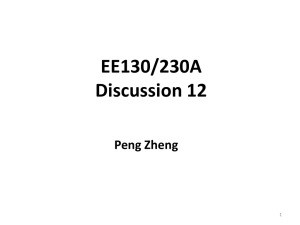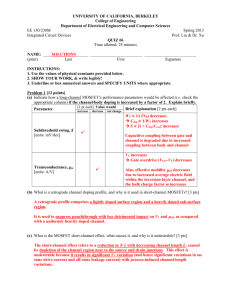Lecture 20 OUTLINE The MOSFET (cont’d) I
advertisement
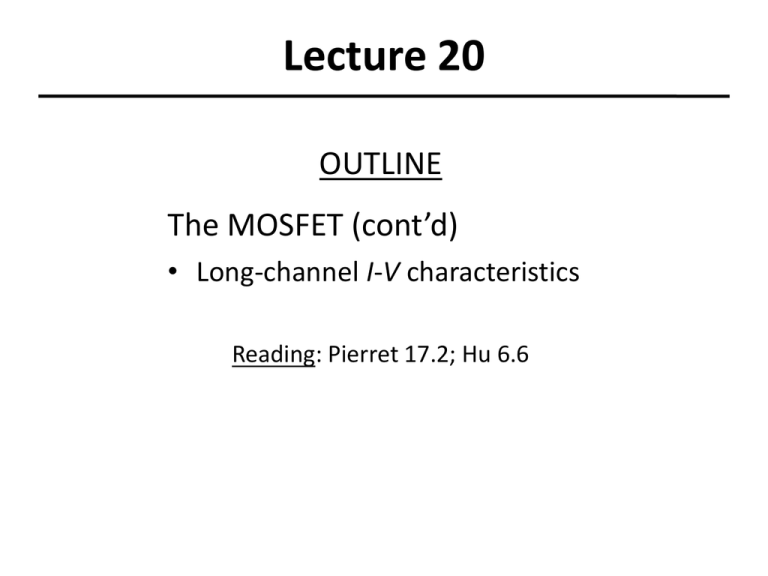
Lecture 20 OUTLINE The MOSFET (cont’d) • Long-channel I-V characteristics Reading: Pierret 17.2; Hu 6.6 Derivation of NMOSFET I-V • VD > VS • Current in the channel flows by drift • Channel voltage VC(y) varies continuously between the source and the drain 2qN A Si (2F VCB ( y)) VT ( y) VFB VCB ( y) 2F Cox • Channel inversion charge density Qdep ( y ) Qinv ( y ) Coxe VG VFB VCB ( y) 2S Coxe W EE130/230A Fall 2013 Lecture 20, Slide 2 R. F. Pierret, Semiconductor Device Fundamentals, Figs. 17.6 1st-Order Approximation • If we neglect the variation of Qdep with y, then Qdep 2qN A Si (2F VSB ) 2qN A Si (2F VSB ) VT ( y) VFB VCB ( y) 2F VSB VSB Cox VT ( y) VT VSB VCB ( y ) where VT is defined to be the threshold voltage at the source end: 2qN A Si (2F VSB ) VT VFB VSB 2F Cox The inversion charge density is then Qinv Coxe VG VT VSB VCB ( y) Coxe VG VT VS VC ( y) EE130/230A Fall 2013 Lecture 20, Slide 3 NMOSFET Current (1st-order approx.) • Consider an incremental length dy of the channel. The voltage drop across this region is dVC I DS dR I DS L 0 dy WTinv I DS I DS dy dy q eff nWTinv Qinv eff W VD I DS dy eff WQinv (VC )dVC I DS I DS VS VD W eff Qinv (VC )dVC VS L VD W eff Coxe VG VT VS VC dVC VS L VDS W eff Coxe VG VT VDS in the linear region L 2 EE130/230A Fall 2013 Lecture 20, Slide 4 Saturation Current, IDsat (1st-order approximation) C. C. Hu, Modern Semiconductor Devices for Integrated Circuits, Figure 6-16 IDS saturates when VD reaches VG-VT Set VD = VG-VT in the equation for ID I Dsat W Coxe eff (VG VT ) 2 2L for VD VDsat VG VT 2qN A Si (2F VSB ) VT VFB VSB 2F Cox EE130/230A Fall 2013 Lecture 20, Slide 5 Problem with “Square Law Theory” • Ignores variation in depletion width with distance y: Qinv Coxe VG VT VS VC 2qN A Si (2F VSB ) where VT VFB VSB 2F Cox EE130/230A Fall 2013 Lecture 20, Slide 6 Modified (Bulk-Charge) I-V Model VG VT In linear region: VD VDsat m W m I Dlin Coxe eff (VG VT VDS )VDS L 2 In saturation region: VD VDsat I Dsat where m 1 EE130/230A Fall 2013 Cdep,min Coxe 1 VG VT m W Coxe eff (VG VT ) 2 2mL 3Toxe WT Lecture 20, Slide 7 since Si 3 SiO2 MOSFET Threshold Voltage, VT The expression that was previously derived for VT is the gate voltage referenced to the body voltage that is required reach the threshold condition: 2qN A Si (2F VSB ) VT VFB VSB 2F Cox Usually, the terminal voltages for a MOSFET are all referenced to the source voltage. In this case, 2qN A Si (2F VSB ) VT VFB 2F Cox and the equations for IDS are W m Coxe eff (VGS VT VDS )VDS L 2 VDS VDsat VGS VT / m I Dlin EE130/230A Fall 2013 Lecture 20, Slide 8 W Coxe eff (VGS VT ) 2 2mL VDsat VGS VT / m I Dsat VDS The Body Effect Note that VT is a function of VSB: 2qN A Si (2F VSB ) VT VFB 2F Cox 2qN A Si (2F ) 2qN A Si (2F ) 2qN A Si (2F VSB ) VFB 2F Cox Cox Cox 2qN A Si VT 0 2F VSB 2F VT 0 g 2F VSB 2F Cox where g is the body effect parameter When the source-body pn junction is reverse-biased, |VT| is increased. Usually, we want to minimize g so that IDsat will be the same for all transistors in a circuit. EE130/230A Fall 2013 Lecture 20, Slide 9 MOSFET VT Measurement • VT can be determined by plotting IDS vs. VGS, using a low value of VDS IDS VGS EE130/230A Fall 2013 Lecture 20, Slide 10 Long-Channel MOSFET I-V Summary • In the ON state (VGS>VT for NMOS; VGS<VT for PMOS), the inversion layer at the semiconductor surface forms a “channel” for current to flow by carrier drift from source to drain In the linear region of operation (VDS < (VGSVT)/m): VDS I DS I Dlin WQinvv WQ inv eff WQ inv eff L mVDS Qinv Coxe VGS VT 2 m 1 Cdep,min Coxe eff f VGS In the saturation region of operation (VDS > (VGSVT)/m): W I DS I Dsat Coxe eff (VGS VT ) 2 1 VDS VDSsat 2mL EE130/230A Fall 2013 Lecture 20, Slide 11
